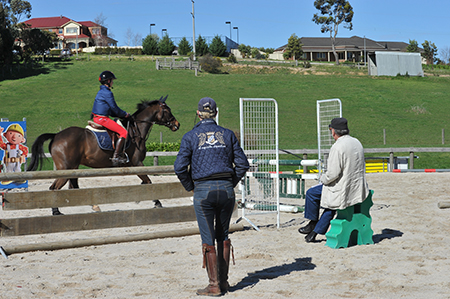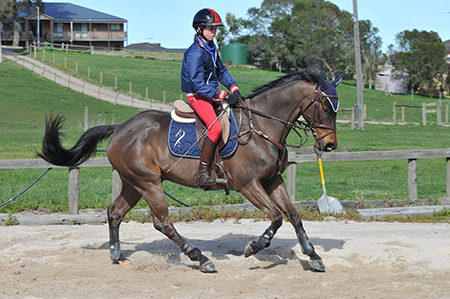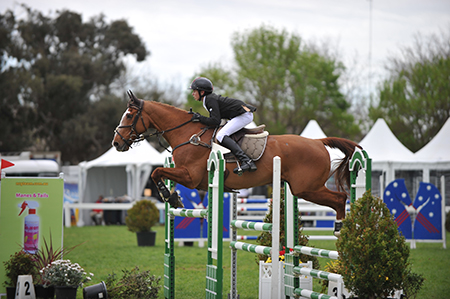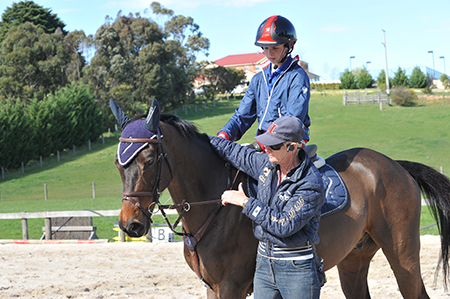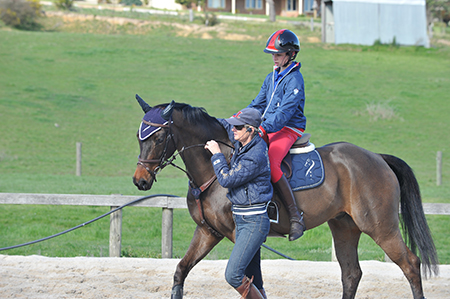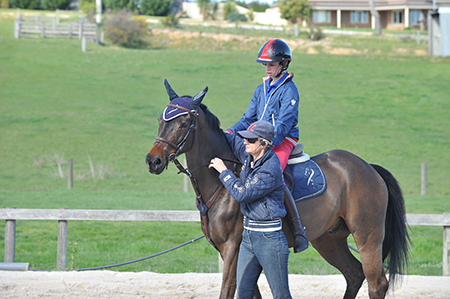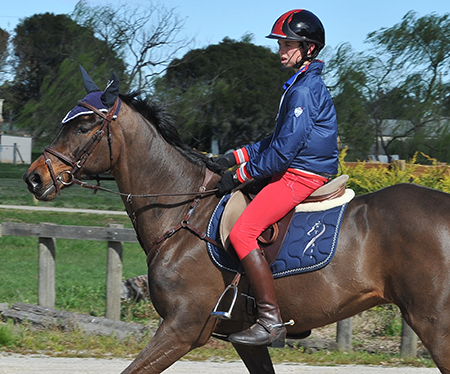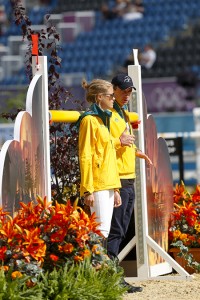Story – Chris Hector & Photos – Roz Neave
Although acceptance of contact is no more important than all the other elements of the training scale – like relaxation, rhythm and straightness – contact problems show up so much more obviously. The contact ‘issue’ is the barometer of good riding and correct training, and that was the difficult lesson 13-year-old Jacob Wells was having to absorb in his training session with Michelle Strapp.
Like so many young Australian riders, Jacob was doing it hard, trying to learn his rider skills on Will, a horse that needs education: “It’s not an ideal situation,” Michelle points out, “Jacob really needs a horse with more mileage, but they are so hard to find. This horse is cute, with a nice canter, but it is also very spooky and very cheeky – sometimes it will just stand in the corner saying I don’t want to know…”
Jacob working on improving canter quality and his position…
“The horse is ten years old but has done very little. He’s a Warmblood by Cooperit, who just never remembered to grow. He has a good ground-covering stride for his size, and lots of jump in his canter. However his mouth can be too fine and he likes to travel behind the bridle. Jacob is having to learn – even though the canter felt elevated and the contact was light – it was not a true contact and the canter was elevated because the horse was not going forward from the leg. This all became obvious to Jacob when Will started stopping at spooky fences and Jacob’s leg had no meaning to Will.”
…and at the Australian Championships with his schoolmaster, Isle of Rahn
When Michelle first spotted Jacob at a training day almost a year ago, he was something of a rough diamond:
“I met Jacob at a pony club rally in Pakenham. He was smaller than he is now, I’m not sure he knew what lead he was on, he was cutting corners, flying lower legs, couldn’t ride a straight line, eyes down… but he quickly showed he is an impeccable pupil, and he has a task here. For the first time he is having to bring on his own young horse, and it does have one of those mouths that gets offended easily. It’s not easy, but he has a lot of patience, he is diligent, he works hard and he has a lot of discipline. After the rally he emailed me and asked if I would teach him ‘this dressage stuff’ and I couldn’t have taken on a better pupil. He has a lot of natural ability, it is just that no-one had given him any skills…”
The theme for the day is apparent the minute the warm-up begins:
“Remember Jacob, the softness of your arms affects the quality of the release and the contact. Keep your elbows soft and watch that your left hand doesn’t get flat. It is your left arm that gets stiffer. When he comes above the bridle, you be the still one, don’t overreact to his busy-ness in the bridle.”
“If he wants to look at something outside the arena, use a little inside leg so he is thinking about you. The most important thing with spooky horses is that they must be in front of your leg, but you need to concentrate on not letting your elbows get tight – he gets easily offended by the hand. He is a bit mouthier than he usually is today. The trouble is when horses become fragile to the bridle, you are required to be extremely tactful with your hands, otherwise they are going to overreact to your hands, and be thinking more about your hands than the fence presented in front of them. When he gets busy with his mouth, you be the still one, try and stabilize the contact by just being still, and riding forward on your line and in the rhythm you want to travel. If he does not accept the contact, you are going to find it hard to have adjustability to the fences.”
“You want your hands still, but not with rigid arms, feel your arms melting, your elbows softer – that’s how we will improve your releases…”
“Aim for equal weight to both reins, slightly change the bend at the base of the horse’s neck and in his ribs – slow and smooth – just a little bend to the left, left leg, a little bend outside, right leg, to get him softer in his body not his mouth, then slightly bring your hands forward for a release, all slow and smooth. Learn to feel what his body is doing.”
“When you gave the reins then, he was offended – what does that tell us? That he is easily offended, yes, but also that your arm is tight, that you are not allowing your arm to let go, or he would be used to it. Your goal has to be that in your canter, you can start to give the rein, and he will lower his neck and go forward because that is exactly what you want him to do in the air.”
“Bring the horse over here, I want to feel his mouth.”
Michelle takes a rein and asks the horse to bend to the inside, and he does so comfortably, then she gets Jacob to ride the horse forward in walk, while she maintains contact on the reins.
“What I feel is a horse that is not worried about my hand – see he will walk forward to the contract, but if I bounce the contact, then he is offended. I think part of the problem might be that the horse you previously rode had a wooden mouth, and if you were a bit abrupt with your hands, it didn’t matter. This horse is more sensitive, he’s waiting for the contact to bounce, it does make it difficult for you. However this is what learning is all about, and if you want to develop horses in the future these are skills you will need.”
“You have to be able to use the opening rein, direct rein and release with a floating arm and hands. You have to learn to separate your arms from your body through the air, and not throw your body forward and your legs back with trapped elbows. You need to maintain your position and follow the bridle with your arms, this can only happen if you relax your elbows.”
“Think about it, when you got this horse, you discovered he did not want to go forward to spooky fences and started stopping, so we had to deal with that. You needed to teach him to be more responsive to your leg, and you turned an idle motor into a Ferrari – but with more motor you’ve got to have a better contact. It’s Catch 22, you’ve got him more responsive to your leg, which means he is thinking more forward, but he won’t go into the bridle because he is unhappy with the contact. Your new created energy does not give you the response you want… today he does not want to go forward because of the contact, not because he is slow off the leg. Right now, it’s better that you stay in 1.10m classes and get really confident cantering around them and let’s get a better balance between hand and leg before we step up.”
“Every horse we ride brings out our weak links, by the time you’ve finished with this horse, you’ll have perfect hands. The horse you were used to riding was so big and dull, and you were so small, that you learnt to lug it around – it is important that the next horse for you doesn’t have a ‘tank’ mouth.”
And of course the problem became more of a problem when Jacob starting riding around the little course, so much so, that Michelle decided that it was time to take a step back: “He is much too fragile in the mouth, that’s why you didn’t have many options to that fence. You have a very good instinct to get to a fence, but you had to get rough to manufacture the result, it all gets a bit busy. Keep it simple go back a step, straight lines.”
“Simple changes not flying changes. As he is just running away from the leg, he is not thinking change, still hands, practise those basics over and over, and that is what produces a good horse. It’s a problem with green horses, they are going well and then suddenly a problem appears, like today with the mouth. We have to try and keep it simple and easy, so those problems don’t get out of hand. So today, we go back to the flat, go back to getting the horse confident in your hand, we have to be ready to step back to go forward…”
Later Michelle took time to talk about the issue of contact. I put it to her, that while all the rungs on the training scale were equally important, contact was the issue that showed up most dramatically…
“If you get all the other things – let’s say you get the power working, you get your horse in front of the leg, but if it doesn’t like going to the contact, then it really shows up, the horse has to put its energy somewhere, if not to the contact, then the horse finds many other solutions, generally ones we do not want. You sit on some horses and they are so far behind your leg, the rider thinks the horse has accepted the contact, but they are not actually going there. Contact is the acceptance of power coming forward to it, and being able to contain the power. You direct the horse’s power towards your contact, and I believe that a horse’s hind legs often reflect a rider’s hands. It is about being able to contain power, straightness, about being able to re-balance your horse, and if the horse is unhappy with the contact, you are not going to be able to do anything. You might as well ride on the end of the buckle… and it’s impossible to jump riding on the buckle unless you are some kind of freak. This is also why we see horses jumping in Hackamores, it gives you control with horses that do not like contact for different reasons. ”
“When I had my very first lesson with George Morris, I was riding Mickey Mouse, and he asked me Michelle what makes your horse go forward? Well my first reaction was ‘leg’, and he said, you are wrong, it’s contact because if you have rigid hands and you create rigid contact, or you have busy hands or you have inconsistent hands – why would the horse ever want to go forward? It is actually your hand that allows a horse to go forward. That doesn’t mean throw away the reins, it means your hand has got to receive energy. It has got to be able to work with the energy so that the horse feels that it wants to create impulsion slightly past the bridle, without running away. You have to get the feeling that your horse wants to go past your hand to a slight extent, that its hind leg wants to push past you but it doesn’t want to go any further, it is still waiting for you but it is confident to think, yeah, I could if I wanted to. It goes without saying, good contact is not possible for a rider to achieve, if they do not have an independent and balanced position.”
Julia Hargreaves on making the transition…
Julia is one rider who has dramatically survived the transition from young rider to senior, and now international, competitor. I asked her what she looked for in a young rider horse…
“For me it depends on the young rider and how competent they are, but if I have to choose one for one of my students, I always go for one that is really brave, I think braveness is the most important quality at the start, and then it is great if they are careful also, but I think it is more important that they are brave and scopey. I think it is a mistake to buy something that is too careful, that can rock their confidence too easily, it puts too much pressure on the young rider, when they already have so much pressure going into the ring, just to get through the finish flags.”
It seems to me that it is getting tougher, the standard of young rider competitions is escalating wildly and it is really tough for ambitious young riders to find good horses…
“I agree, the standard is getting higher all the time, and it is getting more difficult to find that top competitive young rider horse. I know that when I was in the young riders, it was really serious and really competitive, and it seemed there was a great group of young rider horses at that time. A lot of them were imported – Emily, Lauren, Jamie and I, all riding horses from overseas, but it is getting harder to find them.”
What happens in that transition, you obviously made it fairly seamlessly from young riders, to open, to Olympic Games, but there are a lot of riders who disappear in that transition period…
“To be honest, there were definitely classes in my young rider career that I won, and I was successful, but I don’t think I was one of those ones who was guaranteed to win every time she went into the arena. If I wrote down every young rider class that I’ve ridden in, the ones that I got eliminated in, or had a stop – mainly stops and stuff like that – it would definitely outweigh the ones in which I placed. I wasn’t that competitive as a young rider.”
“For the transition into World Cup classes, I was lucky enough to have Hayman, and he looked after me really well, but having said that, the first time I started in a World Cup was Sydney Royal and I was eliminated. I didn’t start again until the following year. It is very quickly forgotten, the fact that I was very bad. When I stepped into the open stuff, I was used to not being a threat or competitive, if I can say that without sounding too depressing. I think the young riders that were really, really successful in their junior/young rider careers, in my generation, a few of them have dropped away because they have other interests. I think that might have been why they were so successful because they went into the ring and they just cantered around because they could. They didn’t put themselves under a huge amount of pressure – but for a rider like me, I had worked so hard, all my thoughts and energy went into it, and the outcome was everything to me. Then the pressure made me screw up a lot more.”
If you have a young rider now that you are mentoring, are you saying that you have to shop in Europe, or do you think you can still find good horses in Australia?
“If you can afford to shop in Europe then it is easier. I guess because I’ve spent the past 12 months in Europe, those are the horses that I have seen. I haven’t seen the horses here, so I haven’t been able to watch and pick one out that I know is a good one. Like when we picked Glenorchy Hope for Georgie Harvey, that was an obvious one because I had been watching him for a little while.”
“If you can afford it, I think there are a lot of options in Europe, but you have to be careful where you go, make sure you have a connection that will come out with something that is reliable. It doesn’t mean there aren’t horses here, it’s just that the horses here that you want to buy are probably not for sale – or they want to sell them, but they want to take them to Europe to sell. It’s a bit like Catch 22, those horses that you would buy from here, end up going to Europe anyway. I guess it all depends on your budget.”

